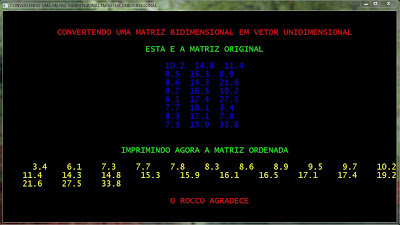Talvez você já precisou imprimir em ordem uma Matriz Bidimensional do tipo float e
encontrou muitas dificuldades, más usando este método
torna-se muito fácil a ordenação. Primeiro a Matriz Bidimensional é transformada em um vetor simples,
veja que ele foi declarado previamente com 24 posições. Dois laços for, sendo um para linhas e outro para colunas,
fazem a varredura em loop, e então atribuimos a mat_triz [] [], ao vetor vet[]; e incrementamos a variável i,
onde junto com o vetor receberão os valores transformados. Agora printf imprime o nosso vetor do tipo float
que recebeu a matriz: mat_triz [] [];
A ordenação mesmo é pelo método da bolha que é um dos métodos mais simples embora a eficiencia não seja das melhores em se tratando de ordenação em muitos itens.
Veja a saída deste programa no cmd:
Copie, cole e compile:
encontrou muitas dificuldades, más usando este método
torna-se muito fácil a ordenação. Primeiro a Matriz Bidimensional é transformada em um vetor simples,
veja que ele foi declarado previamente com 24 posições. Dois laços for, sendo um para linhas e outro para colunas,
fazem a varredura em loop, e então atribuimos a mat_triz [] [], ao vetor vet[]; e incrementamos a variável i,
onde junto com o vetor receberão os valores transformados. Agora printf imprime o nosso vetor do tipo float
que recebeu a matriz: mat_triz [] [];
A ordenação mesmo é pelo método da bolha que é um dos métodos mais simples embora a eficiencia não seja das melhores em se tratando de ordenação em muitos itens.
Veja a saída deste programa no cmd:
Copie, cole e compile:
#include <stdio.h>
#include <conio2.h>
#include <stdlib.h>
int main ( ) {
system (
"title
CONVERTENDO UMA MATRIZ BIDIMENSIONAL EM VETOR UNIDIMENSIONAL" );
int i = 0, ord = 0;
float aux;
float mat_riz [ 8 ] [ 3 ] =
{{ 10.2, 14.8, 11.4 },
{ 9.5, 15.3, 8.9 },
{8.6, 14.3, 21.6 },
{ 9.7, 16.5, 19.2},
{ 6.1, 17.4, 27.5},
{ 7.7, 16.1, 3.4 },
{ 8.3, 17.1, 7.8 },
{ 7.3, 15.9, 33.8}};
float vet [ 24 ];
int g = 0, f;
for ( f = 0; f < 8 ; f++ ) {
for ( g = 0; g < 3 ; g++ ) {
vet [ i ] = mat_riz [ f ] [ g ];
i++;
}
}
textcolor ( LIGHTRED );
gotoxy ( 12 , 3 );
printf ( "CONVERTENDO
UMA MATRIZ BIDIMENSIONAL EM VETOR UNIDIMENSIONAL" );
textcolor ( LIGHTBLUE );
gotoxy ( 32 , 5 );
printf ( "sa_sp10@hotmail.com" );
textcolor ( LIGHTGREEN );
gotoxy ( 25 , 7 );
printf ( "MATRIZ
CONVERTIDA EM VETOR SIMPLES" );
textcolor ( YELLOW );
printf ( "\n\n" );
for ( int i = 0 ; i < 24 ; i++ ) {
printf ( "\t\t\t\tposicao: %i
%.1f\n" , i , vet [ i ] );
Sleep ( 100 ); // Agora temos um
vetor do tipo float
}
Sleep ( 800 );
system ( "cls" );
textcolor ( LIGHTRED );
gotoxy ( 12 , 3 );
printf ( "CONVERTENDO
UMA MATRIZ BIDIMENSIONAL EM VETOR UNIDIMENSIONAL" );
textcolor ( LIGHTGREEN );
gotoxy ( 30 , 5 );
printf ( "ESTA E A
MATRIZ ORIGINAL " );
printf ( "\n" );
textcolor ( LIGHTBLUE );
for ( f = 0; f < 8 ; f++ ) { // Faz a leitura das
linhas
printf ( "\n" );
gotoxy ( 33 , f + 7 );
for ( g = 0; g < 3 ; g++ ) { // Faz a leitura das
colunas
printf ( " %.1f " , mat_riz [ f ] [ g ] ); //Sleep(400);//
Imprime linhas e colunas
}
}
textcolor ( LIGHTGREEN );
gotoxy ( 25 , 17 );
printf ( "IMPRIMINDO
AGORA A MATRIZ ORDENADA" );
textcolor ( YELLOW );
ord = 0;
while ( ord == 0 ) {
ord = 1;
for ( i = 0; i < 24 ; i++ ) {
if ( vet [ i ] > vet [ ( i + 1 ) ] ) {
aux = vet [ i ];
vet [ i ] = vet [ ( i + 1 ) ];
vet [ ( i + 1 ) ] = aux;
ord = 0;
}
}
}
printf ( "\n" );
for ( i = 0; i < 18 ; i++ ) {
gotoxy ( 5 , i + 19 );
for ( i = 0; i < 24 ; i++ )
printf ( " %.1f " , vet [ i ] );
}
textcolor ( LIGHTRED );
gotoxy ( 35 , 23 );
printf ( "\aO ROCCO
AGRADECE" );
getche ( );
}



Nenhum comentário:
Postar um comentário
Observação: somente um membro deste blog pode postar um comentário.